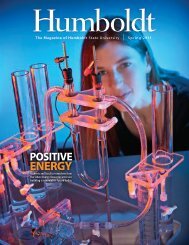Unveiled - Humboldt Magazine - Humboldt State University
Unveiled - Humboldt Magazine - Humboldt State University
Unveiled - Humboldt Magazine - Humboldt State University
You also want an ePaper? Increase the reach of your titles
YUMPU automatically turns print PDFs into web optimized ePapers that Google loves.
Hired at HSU in 1996 to<br />
teach botany, Sillett has since<br />
moved to the Department<br />
of Forestry and Wildland<br />
Resources, a post where he<br />
hopes to do nothing less than<br />
rewrite the book on how redwood<br />
forests are managed.<br />
Ninety-six percent of the<br />
old-growth redwood forest has been logged. “I’m not antilogging,”<br />
he says during a recent visit to Prairie Creek Redwoods<br />
<strong>State</strong> Park and Redwood National Park, where much<br />
of the National Geographic filming took place. “I have no<br />
problem cutting trees. I just think we can do a better job of<br />
picking the trees we cut.”<br />
Sillett believes forestry could benefit by learning the<br />
science of arboriculture. “Arborists know how to promote<br />
tree health. I hope to stimulate a marriage between arboriculture<br />
and forestry.” Current timber practices produce<br />
low-quality lumber by cutting redwoods before they have<br />
time to grow dense, rot-resistant heartwood. By selectively<br />
thinning timberlands and allowing some trees to mature,<br />
the lumber industry could get high-quality wood back into<br />
the marketplace and promote healthier forests. “Historically,<br />
redwood was the best. It built San Francisco twice.<br />
But look at the wood being sold today. There is a little core<br />
of hardwood, and the rest is sapwood. It’s junk.”<br />
Sillett is a man of strong opinions and intense drive. While<br />
others study redwoods from the ground, Sillett goes to the<br />
top. He combines the intellect of a leading scientist with the<br />
adventurousness of an elite climber, and his studies about<br />
redwood physiology are changing conventional wisdom.<br />
For instance, scientists once believed redwoods grew<br />
slower as they aged. “Our work is demonstrating that’s<br />
not true. These trees,” he says, waving his arms at the giant<br />
redwoods surrounding us in Prairie Creek, “are adding<br />
more wood than at any point in their lives.” His studies of<br />
redwood growth rings, obtained by taking core samples<br />
from various heights, are providing the most accurate age<br />
estimates ever for living trees. “We are able to take these<br />
trees back through time and estimate when they were zero<br />
age. That’s never happened before.” Sillett has determined<br />
that one of the largest coast redwoods he’s studied is at least<br />
1,850 years old, give or take 100 years.<br />
“Most scientists are incrementalists,” says Ken Fisher, an<br />
HSU alumnus and financial advisor whose endowment provides<br />
Sillett with a $100,000 annual research budget. “They<br />
work in baby steps. They don’t do anything radical. Steve is<br />
different. He wants to do transformational research that allows<br />
us to make quantum leaps forward. He’s not constrained<br />
in his thinking. That’s what attracted me to him.”<br />
This fall, Sillett expects to launch a groundbreaking<br />
study into the effects of climate change on redwoods. Funded<br />
by the Save the Redwoods League, Sillett and collaborators<br />
“Once a redwood is there, it stays,<br />
and once a forest is established,<br />
it cannot be defeated.<br />
Unless it’s logged.”<br />
will establish research plots<br />
in all the major parks and<br />
reserves for coast redwoods<br />
and giant sequoias.<br />
The study team will include<br />
a dream team of redwood<br />
scientists. Sillett and<br />
U.C. Berkeley professor Todd<br />
Dawson, who did pioneering<br />
research about the utilization of fog by coast redwoods, will<br />
be co-directors. Robert Van Pelt of the <strong>University</strong> of Washington<br />
will be the lead scientist. Anthony Ambrose, a Berkeley<br />
post-doctoral researcher who studied the effects of height<br />
on redwood physiology with Sillett, will analyze carbon and<br />
oxygen isotopes in the tree rings to see how redwoods have<br />
responded to past climatic changes.<br />
“Working with Steve is challenging and rewarding,” says<br />
Ambrose, who earned his master’s degree under Sillett at<br />
HSU in 2004. “He has high standards and demands the best<br />
performance and the most rigorous science.”<br />
Initial climate data are already yielding fascinating insights.<br />
Redwoods in <strong>Humboldt</strong> Redwoods <strong>State</strong> Park appear<br />
to have undergone a growth spurt during the 20th<br />
century. Sillett hypothesizes this may be due to increasing<br />
atmospheric carbon dioxide—so-called CO2 fertilization.<br />
Climate change is a concern because redwoods are adapted<br />
to specific growing conditions. Coast redwoods, which<br />
get water from rain and fog, should endure because the<br />
<br />
Since 1918, the Save the Redwoods League has led the movement<br />
to preserve the ancient coast redwoods and giant sequoias.<br />
Learn more: savetheredwoods.org




